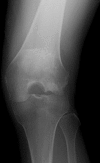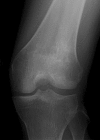Fresh osteochondral allografting for steroid-associated osteonecrosis of the femoral condyles
- PMID: 20143191
- PMCID: PMC2853668
- DOI: 10.1007/s11999-010-1250-7
Fresh osteochondral allografting for steroid-associated osteonecrosis of the femoral condyles
Abstract
Background: Osteonecrosis is a complication of corticosteroid therapy with limited treatment options in young, active patients. These options include debridement, core decompression, osteotomy, allografting, and partial or total knee replacement. Few studies exist regarding the use of osteochondral allografts for treatment of steroid-associated osteonecrosis.
Questions/purposes: We asked if fresh osteochondral allografts would (1) heal to host bone in the presence of osteonecrosis, (2) provide a clinically meaningful decrease in pain and improvement in function, and (3) prevent or postpone the need for prosthetic arthroplasty.
Patients and methods: Twenty-two patients (28 knees) who underwent osteochondral allografting for high-grade, corticosteroid-associated osteonecrosis were evaluated. Their average age was 24.3 years (range, 16-44 years). The mean graft surface area was 10.8 cm(2) (range, 5.0-19.0 cm(2)). Evaluation included a modified (for the knee) D'Aubigné and Postel (18-point) score, International Knee Documentation Committee (IKDC), and Knee Society function scores. The minimum followup was 25 months (mean, 67 months; range, 25-235 months).
Results: Five knees failed. The graft survival rate was 89% (25 of 28). The mean D'Aubigné and Postel score improved from 11.3 to 15.8; 19 of 25 (76%) had a score greater than 15. The mean IKDC pain score improved from 7.1 to 2.0, mean IKDC function score from 3.5 to 8.3, and mean Knee Society function score from 60.0 to 85.7.
Conclusions: Our data suggest osteochondral allografting is a reasonable salvage option for osteonecrosis of the femoral condyles. TKA was avoided in 27 of the 28 of knees at last followup.
Level of evidence: Level IV, case series. See Guidelines for Authors for a complete description of levels of evidence.
Figures







References
-
- Anderton JM, Helm R. Multiple joint osteonecrosis following short-term steroid therapy: case report. J Bone Joint Surg Am. 1982;64:139–141. - PubMed
-
- Bayne O, Langer F, Pritzker KP, Houpt J, Gross AE. Osteochondral allografts in the treatment of osteonecrosis of the knee. Orthop Clin North Am. 1985;16:727–740. - PubMed
-
- D’Aubigne RM, Postel M. Functional results of hip arthroplasty with acrylic prosthesis. J Bone Joint Surg Am. 1954;36:451–475. - PubMed
-
- Fisher DE, Bickel WH. Corticosteroid-induced avascular necrosis: a clinical study of seventy-seven patients. J Bone Joint Surg Am. 1971;53:859–873. - PubMed
-
- Flynn JM, Springfield DS, Mankin HJ. Osteoarticular allografts to treat distal femoral osteonecrosis. Clin Orthop Relat Res. 1994;303:38–43. - PubMed
Publication types
MeSH terms
Substances
LinkOut - more resources
Full Text Sources
Medical
Research Materials

